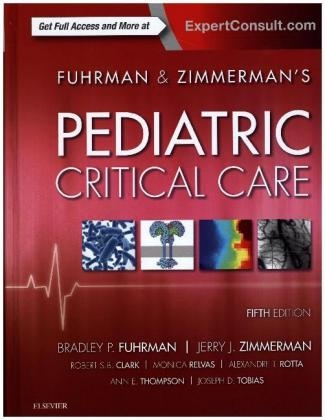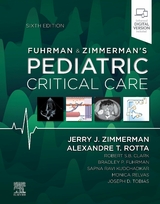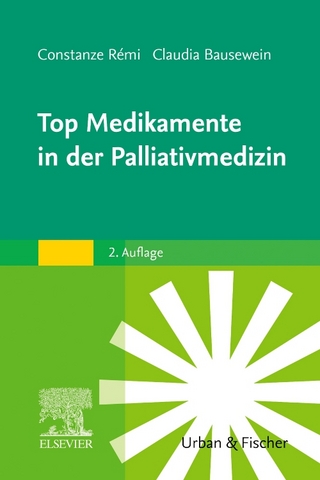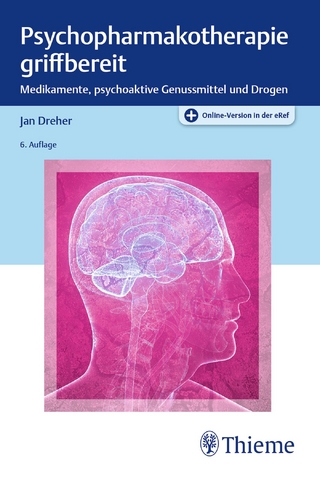
Pediatric Critical Care
Elsevier - Health Sciences Division (Verlag)
978-0-323-37839-0 (ISBN)
- Titel ist leider vergriffen;
keine Neuauflage - Artikel merken
Boasts highly readable, concise chapters with hundreds of useful photos, diagrams, algorithms, and clinical pearls.
Clear, logical, organ-system approach allows you to focus on the development, function, and treatment of a wide range of disease entities.
Expert ConsultT eBook version included with purchase. This enhanced eBook experience allows you to search all of the text, figures, Q&As, and references from the book on a variety of devices.
Includes new content on the expanding use of ultrasound at the bedside and the increase in nursing responsibilities in the PICU.
Eighteen new chapters cover topics such as delirium, metabolism, endocrinology, nutrition, nursing, and much more.
Features expanded and updated information on critical communication, professionalism, long-term outcomes, palliative care, ultrasonography, PCCM in resource-limited settings, ventilator-induced lung injury, non-invasive ventilation, updated CNS pathophysiology, the 'Erythron', and immunity and infection.
Online content is enhanced with over 500 board-style review questions and answers.
Section 1. Pediatric Critical Care: The Discipline
1. History of Pediatric Critical Care
2. High-Reliability Pediatric Intensive Care Unit: Role of Intensivist and Team in Obtaining Optimal Outcomes
3. Subspecialization within Pediatric Critical Care Medicine
4. Critical Communication in the PICU
5. Professionalism in the PICU
6. Nurses in Pediatric Critical Care
7. Research in Pediatric Critical Care
8. Proving the Point: Evidence-Based Medicine in Pediatric Critical Care
9. Prediction Tools for Short Term Outcomes Following Critical Illness in Children
10. Long-Term Outcomes Following Critical Illness in Children
11. Safety and Quality Assessment in the Pediatric Intensive Care Unit
12. Information Technology in Critical Care
13. Building Partnerships: Patient- and Family-Centered Care in the Pediatric Intensive Care Unit
14. Ethics in Pediatric Intensive Care
15. Ethical Issues in Death and Dying
16. Palliative Care in the Pediatric Intensive Care Unit
17. Process of Organ Donation and Pediatric Donor Management
18. Pediatric Transport: Shifting the Paradigm to Improve Patient Outcome
19. Pediatric Vascular Access and Centeses
20. Emerging Role of Ultrasonography in the PICU
21. Pediatric Intensive Care in Resource-Poor Settings
22. Educating the Intensivist
23. Lifelong Learning
24. Public Health Emergencies and Emergency Mass Critical Care
Section 2. Cardiovascular System
25. Structure and Function of the Heart
26. Regional Peripheral Circulation
27. Endothelium and Endotheliopathy
28. Principles of Invasive Monitoring
29. Assessment of Cardiovascular Function
30. Myocardial Dysfunction, Extracorporeal Life Support, and Ventricular Assist Devices
31. Echocardiography Imaging: Noninvasive Cardiac Diagnostics
32. Diagnostic and Therapeutic Cardiac Catheterization
33. Pharmacology of the Cardiovascular System
34. Cardiopulmonary Interactions
35. Disorders of Cardiac Rhythm
36. Shock States
37. Pediatric Cardiopulmonary Bypass
38. Critical Care after Surgery for Congenital Cardiac Disease
39. Cardiac Transplantation
40. Acute and Chronic Heart Failure
41. Physiologic Foundations of Cardiopulmonary Resuscitation
42. Performance of Cardiopulmonary Resuscitation in Infants and Children
Section 3. Respiratory System
43. Structure and Development of the Upper Respiratory System in Infants and Children
44. Structure and Development of the Lower Respiratory System in Infants and Children
45. Physiology of the Respiratory System
46. Noninvasive Respiratory Monitoring and Assessment of Gas Exchange
47. Overview of Breathing Failure
48. Ventilation/Perfusion Inequality
49. Mechanical Dysfunction of the Respiratory System
50. Specific Diseases of the Respiratory System: Upper Airway
51. Pediatric Acute Respiratory Distress Syndrome
52. Ventilator-Induced Lung Injury
53. Asthma
54. Neonatal Respiratory Disease
55. Pneumonitis and Interstitial Disease
56. Diseases of Pulmonary Circulation
57. Mechanical Ventilation and Respiratory Care
58. Non-Invasive Ventilation
59. Extracorporeal Life Support
Section 4. Central Nervous System
60. Structure, Function, and Development of the Nervous System
61. Brain Malformations
62. Neurological Assessment and Monitoring
63. Neuroimaging
64. Pediatric Neurocritical Care
65. Coma and Depressed Sensorium
66. Intracranial Hypertension and Brain Monitoring
67. Status Epilepticus
68. Hypoxic Ischemic Encephalopathy: Pathobiology and Therapy of the Post-Circulatory Arrest Syndrome in Children
69. Pediatric Stroke and Intracerebral Hemorrhage
70. Central Nervous System Infections and Related Conditions
71. Acute Neuromuscular Diseases and Disorders
Section 5. Renal, Fluids, Electrolytets
72. Renal Structure and Function
73. Fluid and Electrolyte Issues in Pediatric Critical Illness
74. Tests of Renal Function
75. Glomerulotubular Dysfunction and Acute Renal Failure
76. Acid-Base Disorders
77. Renal Pharmacology
78. Pediatric Renal Replacement Therapy in the Intensive Care Unit
79. Acute Sever Hypertension
Section 6. Metabolism, Endocrinology, and Nutrition
80. Cellular Respiration
81. Biology of the Stress Response
82. Inborn Errors of Metabolism
83. Genomic Variation in Health and Disease
84. Molecular Foundations of Cellular Injury: Necrosis, Apoptosis and Autophagy
85. Common Endocrinopathies in the PICU
86. Diabetic Ketoacidosis
87. Nutrition in the Critically Ill Child
Section 7. Hematology-Oncology
88. Structure and Function of Hematopoietic Organs
89. Erythron in Critical Illness
90. Hemoglobinopathies
91. Coagulation and Coagulopathy in Critical Illness
92. Thrombosis in Pediatric Critical Care
93. Transfusion Medicine in the PICU
94. Hematology and Oncology Problems in the Intensive Care Unit
95. Critical Illness Involving Children Undergoing Hematopoietic Cell Transplantation
Section 8. Gastrointestinal System
96. Gastrointestinal Structure and Function
97. Disorders and Diseases of the Gastrointestinal Tract and Liver
98. Applications of Gastrointestinal Pharmacology
99. Acute Liver Failure, Liver Transplantation, and Extracorporeal Liver Support
100. Acute Abdomen
Section 9. Immunity and Infection
101. The Innate Immune System
102. Adaptive Immunity
103. Congenital Immunodeficiency
104. Acquired Immune Dysfunction
105. Immune Balance in Critical Illness: SIRS, CARS, Immune Paralysis
106. Pediatric Rheumatic Disease: Diagnosis, Treatment, and Complications
107. Bacterial and Fungal Infections, Antimicrobials, and Antimicrobial Resistance
108. Life-Threatening Viral Diseases and Their Treatment
109. Infectious Syndromes in the PICU
110. Hospital-Acquired Infection in the PICU: Epidemiology and Control
111. Sepsis
112. Multiple Organ Dysfunction/Failure Syndrome in Children
Section 10. Environmental Hazards
113. Bites and Stings
114. Heat Injury
115. Accidental Hypothermia
116. Drowning
117. Burn and Inhalation Injuries
Section 11. Pediatric Trauma
118. Evaluation, Stabilization and Initial Management After Multiple Trauma
119. Severe Traumatic Brain Injury in Infants and Children
120. Thoracic Injuries in Children
121. Abdominal Trauma in Pediatric Critical Care
122. Child Abuse
123. Violence-Associated Injury Among Children
Section 12. Pharmacology and Toxicology
124. Principles of Drug Disposition in the Critically Ill Child
125. Molecular Mechanisms of Drug Actions: From Receptors to Effectors
126. Adverse Drug Reactions and Drug-Drug Interactions
127. Principles of Toxin Assessment and Screening
128. Toxidromes and Their Treatment
Section 13. Anesthesia Principles for the PICU
129. Airway Management
130. Anesthesia Effects and Organ System Considerations
131. Anesthesia Principles and Operating Room Anesthesia Regimens
132. Malignant Hyperthermia
133. Neuromuscular Blocking Agents
134. Sedation and Analgesia
135. Tolerance, Withdrawal, and Dependency
136. Pediatric Delerium
| Erscheinungsdatum | 04.12.2016 |
|---|---|
| Zusatzinfo | Approx. 841 illustrations (636 in full color) |
| Verlagsort | Philadelphia |
| Sprache | englisch |
| Maße | 222 x 281 mm |
| Gewicht | 4420 g |
| Themenwelt | Medizin / Pharmazie ► Medizinische Fachgebiete ► Intensivmedizin |
| Medizin / Pharmazie ► Medizinische Fachgebiete ► Pädiatrie | |
| ISBN-10 | 0-323-37839-0 / 0323378390 |
| ISBN-13 | 978-0-323-37839-0 / 9780323378390 |
| Zustand | Neuware |
| Haben Sie eine Frage zum Produkt? |
aus dem Bereich



